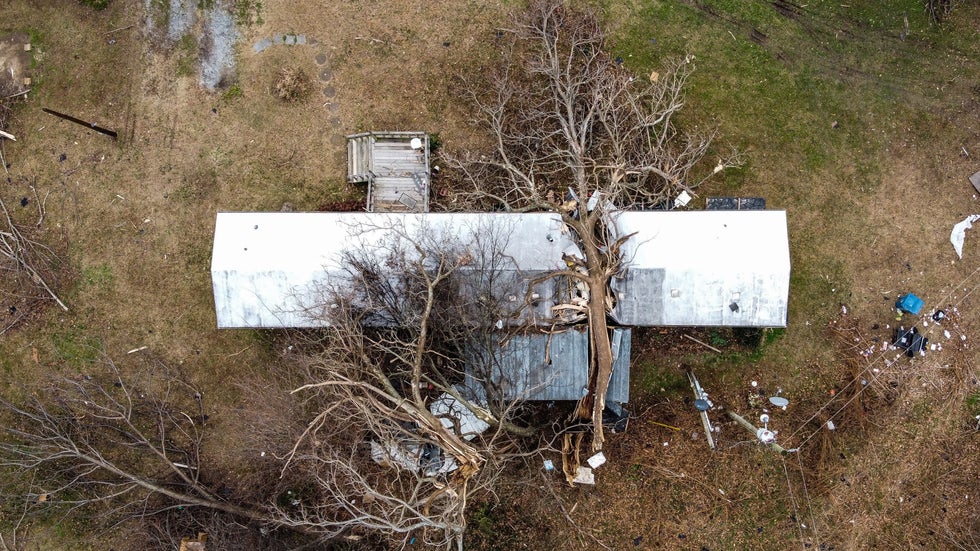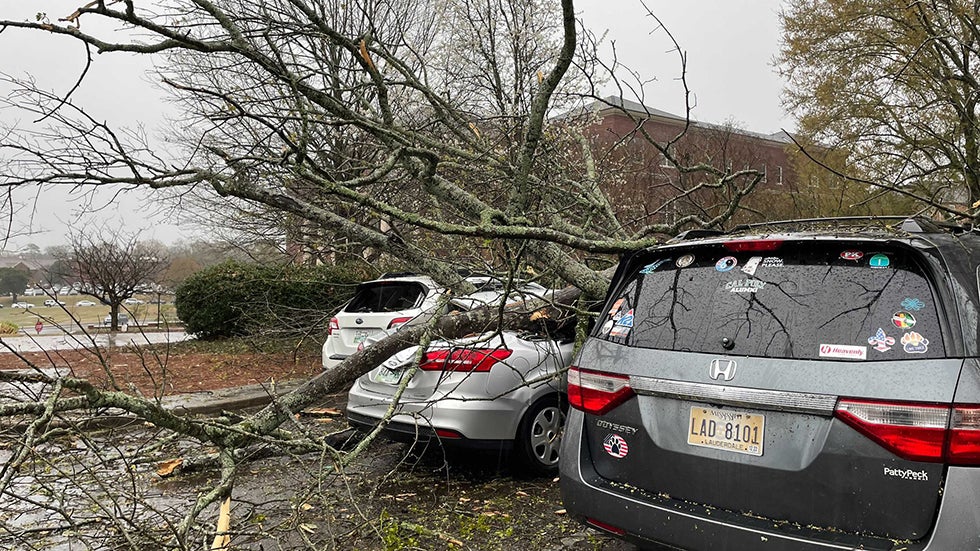Jan Wesner Childs
 This aerial view shows a fallen tree on a house in Cayce, Kentucky, on December 15, 2021, five days after tornadoes hit the area.
This aerial view shows a fallen tree on a house in Cayce, Kentucky, on December 15, 2021, five days after tornadoes hit the area.Sign up for the Morning Brief email newsletter to get weekday updates from The Weather Channel and our meteorologists.
Raegan Mae Lee, 22 months old, was asleep in her bed when a tree fell on her family's home in Pearl River County, Mississippi, in the early-morning hours of April 24, 2021.
The little girl was killed, an example of just one of the many people killed by weather-felled trees every year in the United States.
"She could always put a smile on your face with her little smile and chubby cheeks," Lainey Aschenbach wrote on a fundraising page established for the Lee family. "She loved to play outside and loved to play with her big brother."
Death by falling trees is a scenario that plays out in weather ranging from thunderstorms to winter storms to hurricanes.
Anybody who's unlucky enough to experience the type of weather that knocks down large trees has probably heard the unsettling snap, snap, snap of limbs breaking. Those who've survived a tree falling on their home describe it in horrifying detail, often using the same phrase: "It sounded like a bomb went off."
(MORE: 9 Severe Weather Safety Tips That Could Save Your Life)
The National Weather Service doesn't keep statistics on deaths caused by trees.
The agency does track deaths from wind, which is a common reason why trees fall. Wind killed 51 people in the U.S. in 2022, including five aged 9 or younger. Of the total, 36 were killed by what's considered high winds or thunderstorm winds.
The 10-year annual average of wind-related deaths is 53, according to the NWS.
Of the nine categories of weather-related deaths tracked by the weather service, wind had the sixth-highest number in 2022, behind heat, hurricanes, flooding, winter weather and rip currents.
Scientific research is also sparse on the subject.
A study published in 2008 found that 407 people were killed by "wind-related tree failures" in the U.S. between 1995 and 2007.
The most common weather condition at the time of death was a thunderstorm's winds or high winds not associated with thunderstorms, according to the study. Those two criteria accounted for 76% of the deaths. The rest were blamed on trees falling during tropical cyclones, tornadoes or snow and ice events.
It's not surprising that most fallen tree deaths occur during thunderstorms, weather.com senior meteorologist Jon Erdman said.
"In 2020, there were just over 16,000 reports of thunderstorm high winds or thunderstorm wind damage in the U.S., according to NOAA's Storm Prediction Center," Erdman said. "In general, winds over 60 mph, which are common in severe thunderstorms, tropical storms, hurricanes and nor'easters, are capable of downing trees."
The stronger the winds, the more likely trees are to be felled.
"Long-lived lines of severe thunderstorms known as derechos can produce damaging wind gusts over 250 miles long, downing thousands of trees," Erdman added. "This is not only a danger for homeowners, but also for campers who may be enjoying a vacation in a heavily wooded area."
(MORE: Here Are the Ingredients That Trigger a Severe Weather Outbreak)
Rain, whether during a thunderstorm or otherwise, can also contribute.
"If the ground is saturated from previous heavy rain, as can often be the case in the South, it doesn't take as strong a wind gust to blow a tree over," Erdman said. "That's because wet soil doesn't hold the tree's roots in the ground as solidly as dry soil does. Instead, the roots can eventually slosh through the soupy wet soil, increasing the danger of the tree eventually toppling over."
Of the known data, people appear most likely to be killed by trees while in their car or at home.
Thirteen of the people who died from wind-related incidents in 2020 were in vehicles, according to the NWS. Ten were listed as being inside their homes, including seven in mobile homes.
Four of the 25 deaths attributed to Hurricane Laura in Louisiana in 2020 were caused by trees, according to the state's Department of Health. Likewise, four of the six deaths blamed on Hurricane Zeta were from falling trees. Three of those were in Georgia, far inland from where the storm came ashore.
 Several cars were crushed by falling trees during severe weather on the campus of Mississippi State University on Tuesday, March 22, 2022.
Several cars were crushed by falling trees during severe weather on the campus of Mississippi State University on Tuesday, March 22, 2022.Erdman says there are several things people can do to help avoid tragedies from falling trees, regardless of where you live or what time of year it is.
"Take shelter for a severe thunderstorm warning just as you would a tornado warning, in a basement, or if not available, an interior room on the lowest floor of your home," he said.
If in a vehicle or outside, seek shelter in a substantial, sturdy building as soon as possible. Always have multiple ways to receive severe weather alerts. And have an arborist inspect the trees around your home at least once a year.
"If you notice a tree leaning, particularly toward your home, have it removed immediately," Erdman said. "Finding and removing an unhealthy or leaning tree that could fall in a storm is a much better option than the danger and damage from a fall onto your home, much less the deductible from your homeowner's policy."
And it could save your life.
Harvey Hillman Sr. was walking to his truck in Riverdale, Georgia, to head to work on the stormy morning of April 26. Hillman never made it to his vehicle - he was hit and killed by a falling tree in his driveway, WSB-TV reported.
Hillman's stepdaughter, Mavis Freeman, shared this with the station: "I'll tell anybody if you have trees over your house, cut them."
The Weather Company’s primary journalistic mission is to report on breaking weather news, the environment and the importance of science to our lives. This story does not necessarily represent the position of our parent company, IBM.
The Weather Company’s primary journalistic mission is to report on breaking weather news, the environment and the importance of science to our lives. This story does not necessarily represent the position of our parent company, IBM.

No comments:
Post a Comment